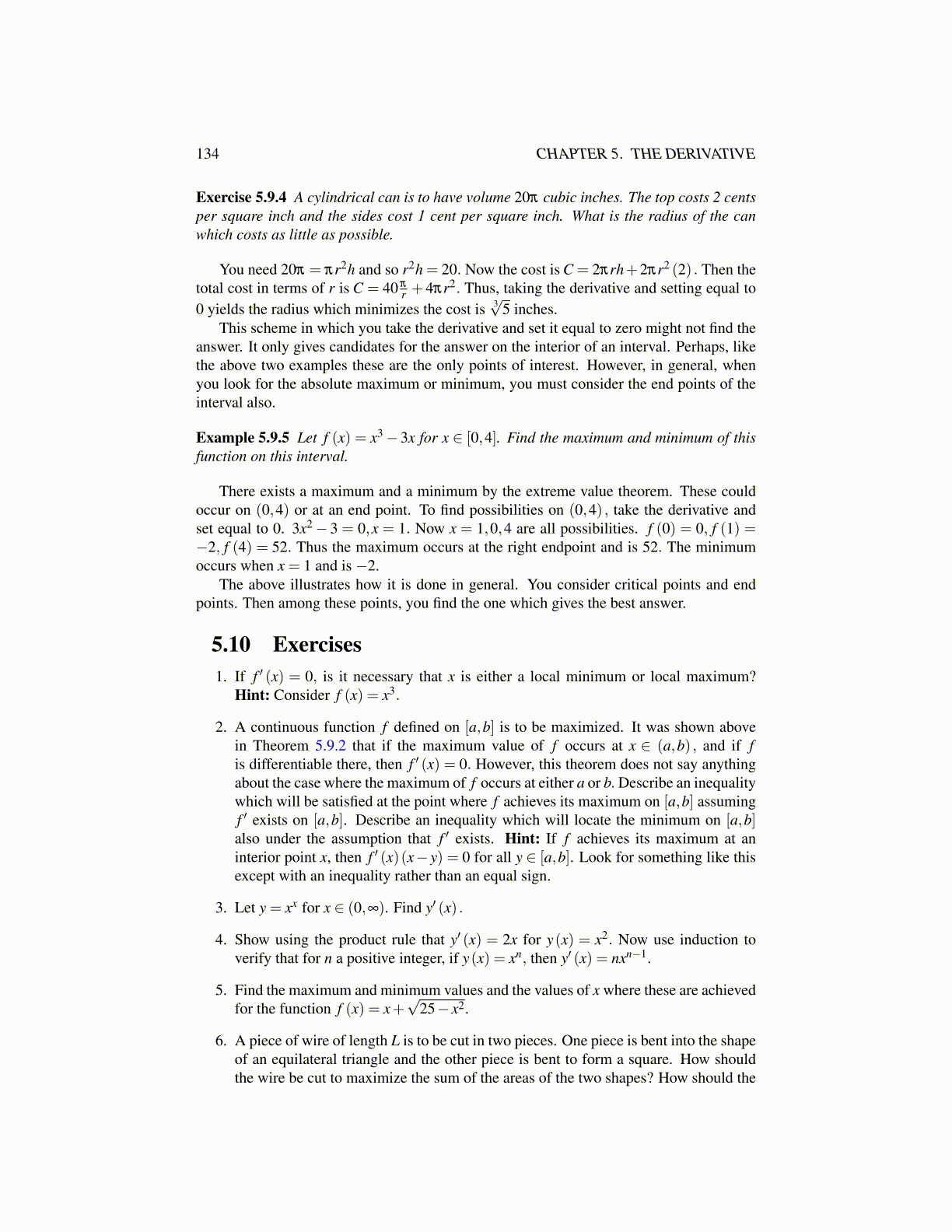
134 CHAPTER 5. THE DERIVATIVE
Exercise 5.9.4 A cylindrical can is to have volume 20π cubic inches. The top costs 2 centsper square inch and the sides cost 1 cent per square inch. What is the radius of the canwhich costs as little as possible.
You need 20π = πr2h and so r2h = 20. Now the cost is C = 2πrh+2πr2 (2) . Then thetotal cost in terms of r is C = 40 π
r +4πr2. Thus, taking the derivative and setting equal to0 yields the radius which minimizes the cost is 3√5 inches.
This scheme in which you take the derivative and set it equal to zero might not find theanswer. It only gives candidates for the answer on the interior of an interval. Perhaps, likethe above two examples these are the only points of interest. However, in general, whenyou look for the absolute maximum or minimum, you must consider the end points of theinterval also.
Example 5.9.5 Let f (x) = x3 −3x for x ∈ [0,4]. Find the maximum and minimum of thisfunction on this interval.
There exists a maximum and a minimum by the extreme value theorem. These couldoccur on (0,4) or at an end point. To find possibilities on (0,4) , take the derivative andset equal to 0. 3x2 − 3 = 0,x = 1. Now x = 1,0,4 are all possibilities. f (0) = 0, f (1) =−2, f (4) = 52. Thus the maximum occurs at the right endpoint and is 52. The minimumoccurs when x = 1 and is −2.
The above illustrates how it is done in general. You consider critical points and endpoints. Then among these points, you find the one which gives the best answer.
5.10 Exercises1. If f ′ (x) = 0, is it necessary that x is either a local minimum or local maximum?
Hint: Consider f (x) = x3.
2. A continuous function f defined on [a,b] is to be maximized. It was shown abovein Theorem 5.9.2 that if the maximum value of f occurs at x ∈ (a,b) , and if fis differentiable there, then f ′ (x) = 0. However, this theorem does not say anythingabout the case where the maximum of f occurs at either a or b. Describe an inequalitywhich will be satisfied at the point where f achieves its maximum on [a,b] assumingf ′ exists on [a,b]. Describe an inequality which will locate the minimum on [a,b]also under the assumption that f ′ exists. Hint: If f achieves its maximum at aninterior point x, then f ′ (x)(x− y) = 0 for all y ∈ [a,b]. Look for something like thisexcept with an inequality rather than an equal sign.
3. Let y = xx for x ∈ (0,∞). Find y′ (x) .
4. Show using the product rule that y′ (x) = 2x for y(x) = x2. Now use induction toverify that for n a positive integer, if y(x) = xn, then y′ (x) = nxn−1.
5. Find the maximum and minimum values and the values of x where these are achievedfor the function f (x) = x+
√25− x2.
6. A piece of wire of length L is to be cut in two pieces. One piece is bent into the shapeof an equilateral triangle and the other piece is bent to form a square. How shouldthe wire be cut to maximize the sum of the areas of the two shapes? How should the